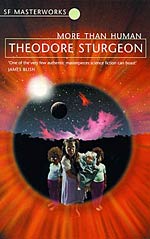
![]() Emil
Emil
7/10/2012
![]()
Often one reads a novel that carries you through the narrative by the sheer power of the author's imagination and the beauty and subtlety of their prose, even if the storytelling does not always meld as smoothly as it could. More Than Human is just such a narrative, particularly through the slow emergence of Lone from his almost vegetable state to an awareness of the world around him and his own responses to the people in it. It is vivid, artful and intensely imagined writing.
Sturgeon takes an array of ideas about psychology and the potential abilities of the mind and uses them to describe what the next stage of human development might be like. Instead of "traditional" physical evolutionary processes, or even an a-typical "uplift" scenario as found in Clarke's Childhood's End, telepathic powers and a kind of super-human, Homo Gestalt, is proffered.
The novel consists of three parts (originally published as three separate novellas), which traces the progress of a group of misfits as they gradually unite to form Homo Gestalt, which transcends Homo Sapiens. They are an idiot boy with telepathic powers called Lone, black twins with telekinetic powers and what appears to be a severely retarded baby, but who possesses hidden and astonishing mental gifts. Lone dies and is replaced by the more-than-mischievous orphan Gerry, prepared to kill to maintain the group's cohesion. Later Hip Burrows arrives, whose coming make the entity complete, as its conscious. Sturgeon splendidly unfolds this evolvement.
More Than Human is certainly a sophisticated and ambitious classic, well worth its inclusion on every list it appears in. Sturgeon grapples with ideas and themes that less adventurous genre writers to this day still ignore, making More Than Human one of those truly rare and authentic achievements in science fiction. Its awareness of the tragic aspects of human interaction, the assertion of the redemptive power of love and Jungian symbolism will stay with me for a long time.